SCHEME OF WORK
WEEK TOPIC
1. Revision of First Term’s work
2. Bank service: commercial bank – services provided by commercial banks, Ethical issue in banking
3. Insurance: definition of insurance, insurance services, types of insurance policy – vehicle, fire, burglary, marine, Life insurance, pension, health, etc and benefits of insurance
4. Book keeping – Ledger Entries: ledger, meaning of ledger, items on a ledger – date, particulars, folio, Discount – amount, how to record cash receive payments = discount received, discount allowed and contra entries
5. Book keeping – petty cash book: meaning of petty cash book, preparation of petty cash book, imp rest system – petty cash, refinement and reimbursement.
6. Cash Book; Meaning of cash book, types of cash book – single column cash book, two/double column cash book, items on a column cash – cash column, bank column and discount column, preparation of cash book – cash column, bank column and discount column, preparation of cash book.
7. Pitman shorthand(vowel placement): Vowels: Placement(first second and third), Types (eeou), word drills.
8. Pitman shorthand(Third group of consonants and vowel): Consonants and Vowels – Third group of consonants ( k, g m, n, ng, I , w, y), first place Vowels(ah, oo, aw), Third place( e, I, oo, oo)
9. Pitman shorthand (consonant R & H): Consonant Vowels – The fourth(last group of consonants (R & H), Forems or R & H – Upward, Downward, Diphthongs and triphone – meaning , shorthand outlines and signs.
10. Pitman shorthand(vowel placement): Vowels: Placement(first second and third), Types (eeou), word drills.
11. Revision
2ND TERM
WEEK 1
LESSON 1
Bank and Their Services
Preview
1. Bank service: commercial banks
2. Functions/Services provided by commercial banks,
3. Ethical issues in banking
Banks are public limited liability companies that are in the business of providing financial services to consumers and businesses. They receive, transfer, pay, exchange, lend, invest and safeguard money for people or companies.
COMMERCIAL BANKS
A commercial bank is a financial institution that renders financial services to customers. It performs a number of functions which are listed below:

FUNCTIONS/SERVICES OF COMMERCIAL BANKS
1. Accepting deposits from depositors/customers
2. Keeping money and valuables in safety for customers
3. Assisting customers with loan and overdraft to start or expand their business
4. Giving financial/investment advice to customers
5. Trading in foreign currency and giving traveler’s cheque to customers travelling abroad.
6. Assisting customers to transfer money from one country to another
7. Acting as a trustee or guarantor on behalf of their customers.
Let’s take a closer look into each of the functions.
1. Acceptance of Deposit: By accepting deposits from borrowers and then lending the money to borrowers, banks encourage the flow of money to productive use and investment. This in turn allows the economy to grow.
2. Keeping Valuables in Safety for Customers: Commercial banks help in safe-keeping valuables such as jewelries, company’s share certificates, etc and thereby prevent such from being stolen or damaged.
3. Assisting Customers with Loans: This effort provide ready fund to those who want to engage in business but lack the fund to go into such businesses.
4. Giving Financial Advice to Customers: This helps prevent taking risk that could affect customers financially.
ETHICAL ISSUES IN BANKING
1. Banks should keep all financial matters of individuals confidential.
2. Bank officials must keep customer’s account accurate.
3. Officials of bank must avoid stealing from the bank.
4. Bank clerks must not steal from customers.
5. Banks must follow government regulation.
6. Bank should not give false report to the government.
7. There should be no cover up of customers’ financial crime.
8. All documents related to criminal activities must be made available to the appropriate government agencies when demanded.
EVALUATION
Objectives:
1. Which of the following is not among banking services
a. Loans b. Traveller’s Cheque c. Banker’s draft
2. Which of the following is not an ethical issue in the banking sector?
a. Confidentiality b. Integrity c. Non-transparency
Theory:
3. Define a commercial bank.
4. When banks allow customers to draw more money than he has in his bank account, this is called_____________
5. Mention five examples of commercial banks around you.
Bank and Their Services
Preview
1. Bank service: commercial banks
2. Functions/Services provided by commercial banks,
3. Ethical issues in banking
Banks are public limited liability companies that are in the business of providing financial services to consumers and businesses. They receive, transfer, pay, exchange, lend, invest and safeguard money for people or companies.
COMMERCIAL BANKS
A commercial bank is a financial institution that renders financial services to customers. It performs a number of functions which are listed below:

FUNCTIONS/SERVICES OF COMMERCIAL BANKS
1. Accepting deposits from depositors/customers
2. Keeping money and valuables in safety for customers
3. Assisting customers with loan and overdraft to start or expand their business
4. Giving financial/investment advice to customers
5. Trading in foreign currency and giving traveler’s cheque to customers travelling abroad.
6. Assisting customers to transfer money from one country to another
7. Acting as a trustee or guarantor on behalf of their customers.
Let’s take a closer look into each of the functions.
1. Acceptance of Deposit: By accepting deposits from borrowers and then lending the money to borrowers, banks encourage the flow of money to productive use and investment. This in turn allows the economy to grow.
2. Keeping Valuables in Safety for Customers: Commercial banks help in safe-keeping valuables such as jewelries, company’s share certificates, etc and thereby prevent such from being stolen or damaged.
3. Assisting Customers with Loans: This effort provide ready fund to those who want to engage in business but lack the fund to go into such businesses.
4. Giving Financial Advice to Customers: This helps prevent taking risk that could affect customers financially.
ETHICAL ISSUES IN BANKING
1. Banks should keep all financial matters of individuals confidential.
2. Bank officials must keep customer’s account accurate.
3. Officials of bank must avoid stealing from the bank.
4. Bank clerks must not steal from customers.
5. Banks must follow government regulation.
6. Bank should not give false report to the government.
7. There should be no cover up of customers’ financial crime.
8. All documents related to criminal activities must be made available to the appropriate government agencies when demanded.
EVALUATION
Objectives:
1. Which of the following is not among banking services
a. Loans b. Traveller’s Cheque c. Banker’s draft
2. Which of the following is not an ethical issue in the banking sector?
a. Confidentiality b. Integrity c. Non-transparency
Theory:
3. Define a commercial bank.
4. When banks allow customers to draw more money than he has in his bank account, this is called_____________
5. Mention five examples of commercial banks around you.
WEEK 2
LESSON 2
INSURANCE
Preview
1. Insurance: definition of insurance.
2. Insurance services.
3. Types of insurance policy – vehicle, fire, burglary, marine, Life insurance, pension, health, etc
4. Benefits of insurance
Meaning of insurance: insurance is the protection against the loss of property and life. With regard to property, insurance covers practically everything an individual or business owns (building, vehicles and even clothes). Insurance can be taken out on practically anything for which risk is associated.
Insurance is usually undertaken when a person enters into an agreement with an insurance company by paying an amount of money called the Premium. The company is known as the Insurer. The person who pays the premium is the insured.

SERVICES PROVIDED BY INSURANCE COMPANIES
1. It provides compensation for losses incurred by individuals and businesses
2. It minimizes losses and risks by spreading it through the creation of a common fund to which many contribute in order to make good the losses of a few.
3. It aids business survival and help them to quickly recover economically from natural or man-made disaster.
4. To help families whose breadwinners may die accidentally while at work
5. Provide sources of fund in case of health break down.
6. Provide continuous funds for those who have retired.
TYPES OF INSURANCE
1. Vehicle insurance: This form of insurance can be taken by any person or business that owns a car. Once an individual has taken out such an insurance, that person is covered against a specific loss.
FORMS OF VEHICLE INSURANCE COVERAGE
• Third party insurance: This policy allows a driver whose car is hit by another car to file a claim against other who is wrong and who holds this type of policy. In other words, the insurance company insures the person which the policy holder may accidentally hit. It provides protection against liability caused by a car accident.
• Comprehensive Insurance: This policy covers the loss incurred by the individual who took out the policy and the person he accidentally hit. The policy holder can also recover a certain percentage, as high as 80% of the cost of the car, if it is stolen, washed away by flood or damaged by a fallen tree.
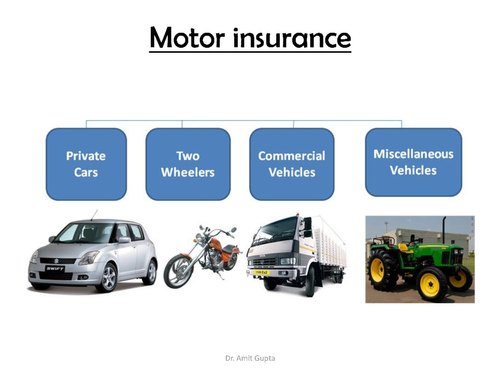
2. Fire insurance: is a coverage against fire hazards which may consume business premises or personal property. In recent years, there have been numerous fire hazards in public buildings. The Republic building in Lagos state, the Cocoa House in Ibadan, the Pay Office in Abuja and NNPC office complex in Lagos and some examples of high rise buildings destroyed by fire in Nigeria. The losses associated with this buildings would have been enormous but for the fact that the owner of this building had insured them against fire hazards. At the occurrence of such fires, the insurance company would pay a sum agreed at the time of insurance.

3. Burglary or Theft insurance: This type of policy covers loss of, or damage to property in the event of burglary or theft. Items that are insured under this class of insurance stock, plant and machinery, household effects, office equipment, etc

4. Marine/Sea Insurance: This is one of the oldest types of insurance. Cover provided by a marine insurance policy is limited to dangers on water, that is, it covers loss of, or damage to ships, and the cargo carried by them.

5. Life Assurance: Life assurance serves a dual purpose. It is a means of reducing the financial burden of a family which the bread winner may bring. It is also a method of saving.
Life assurance is always for a specific period of time during which the assured continues to pay his or her premiums. The payment of such premium may be yearly, quarterly or monthly.
In the event of the assured’s death, the insurance company pays out the sum assured by the policy.

Types of Life Assurance
• Whole life assurance: This policy ensures the payment of the amount of money due at the death of the assured.
• Endowment assurance: This policy is taken up for a specific period, e.g. twenty years.
BENEFITS OF INSURANCE
• Protects capital assets against such risks as fire, theft, accidents.
• Enables the policy holder to form the habit of saving regularly
• Helps the assured to obtain loan for some future business or other projects. For example, in certain circumstances, life assurance can be used as a security for loan.
• Provides cash (an income benefit) for the dependants of the policy holder in the event of death.
• Ensures that worries and embarrassment that might make an individual unhappy and removed, since he is certain that any loss or damaged suffered by him will be made good by the insurance company.
EVALUATION
Objectives:
1. Which of the following is the purpose of insurance? (a) to make profit (b) to make good the loss suffered (c)to collect premium (d) to avoid loss
2. One of the insurance policy is not for motor vehicle (a) third party(b) marine(c) comprehensive (d) theft
3. All the risk stated below are not insurable except (a)storm(b) earthquake(c) gambling (d) thefts
4. What is the sum of money paid by the insured to the insurance company called? (a) discount (b) commission (c) premium (d) dividend
Theory:
1. What is insurance?
2. Why is insurance important to the businessman or individual taking out a policy?
3. What are the benefits of insurance?
LESSON 3
MAIN TOPIC: INSURANCE
SPECIFIC TOPIC: Types of Insurance
REFERENCE BOOKS:
Macmillan JSS1 Business Studies by Awoyokun A.A et al .Pages 37-45
WABP JSS Business Studies 1by Egbe T. Ehiametalor. Pages 62-66
PERFORMANCE OBJECTIVES: At the end of the lesson, students should be able to:
mention types of Insurance
explain the different types of Insurance
CONTENTS:
TYPES OF INSURANCE
Vehicle Insurance
Fire Insurance
Burglary Insurance
Marine Insurance
Pension Insurance Scheme
Health Insurance
Agricultural Insurance
Life Assurance

FIRE INSURANCE: This is coverage against fire accidents which may consume business premises or personal property.
BURGLARY OR THEFT INSURANCE: Business premises may be burgled especially during the night. This type of insurance will enable the business man to recover the value of the items burgled.
MARINE INSURANCE: This is a kind of insurance against risks involved when goods are carried by sea. The policy covers both the ship carrying the goods and the goods themselves.
ADVANTAGES
It eases or reduces the burden of loss on the individual or business taking out the policy
Risks of ownership are minimized
Although life cannot be restored by any insurance policy, the surviving members of a family can be adequately compensated to minimize hardship.
DISADVANTAGES
Some insurance companies usually dodge payment of compensation to the insured when it is necessary to do so.
EVALUATION:
mention five types of Insurance
explain three out of the types of Insurance mentioned
HOME-WORK:
Explain Life Assurance
Mention two advantages and two disadvantages of insurance
What is banking?
INSURANCE
Preview
1. Insurance: definition of insurance.
2. Insurance services.
3. Types of insurance policy – vehicle, fire, burglary, marine, Life insurance, pension, health, etc
4. Benefits of insurance
Meaning of insurance: insurance is the protection against the loss of property and life. With regard to property, insurance covers practically everything an individual or business owns (building, vehicles and even clothes). Insurance can be taken out on practically anything for which risk is associated.
Insurance is usually undertaken when a person enters into an agreement with an insurance company by paying an amount of money called the Premium. The company is known as the Insurer. The person who pays the premium is the insured.

SERVICES PROVIDED BY INSURANCE COMPANIES
1. It provides compensation for losses incurred by individuals and businesses
2. It minimizes losses and risks by spreading it through the creation of a common fund to which many contribute in order to make good the losses of a few.
3. It aids business survival and help them to quickly recover economically from natural or man-made disaster.
4. To help families whose breadwinners may die accidentally while at work
5. Provide sources of fund in case of health break down.
6. Provide continuous funds for those who have retired.
TYPES OF INSURANCE
1. Vehicle insurance: This form of insurance can be taken by any person or business that owns a car. Once an individual has taken out such an insurance, that person is covered against a specific loss.
FORMS OF VEHICLE INSURANCE COVERAGE
• Third party insurance: This policy allows a driver whose car is hit by another car to file a claim against other who is wrong and who holds this type of policy. In other words, the insurance company insures the person which the policy holder may accidentally hit. It provides protection against liability caused by a car accident.
• Comprehensive Insurance: This policy covers the loss incurred by the individual who took out the policy and the person he accidentally hit. The policy holder can also recover a certain percentage, as high as 80% of the cost of the car, if it is stolen, washed away by flood or damaged by a fallen tree.

2. Fire insurance: is a coverage against fire hazards which may consume business premises or personal property. In recent years, there have been numerous fire hazards in public buildings. The Republic building in Lagos state, the Cocoa House in Ibadan, the Pay Office in Abuja and NNPC office complex in Lagos and some examples of high rise buildings destroyed by fire in Nigeria. The losses associated with this buildings would have been enormous but for the fact that the owner of this building had insured them against fire hazards. At the occurrence of such fires, the insurance company would pay a sum agreed at the time of insurance.

3. Burglary or Theft insurance: This type of policy covers loss of, or damage to property in the event of burglary or theft. Items that are insured under this class of insurance stock, plant and machinery, household effects, office equipment, etc

4. Marine/Sea Insurance: This is one of the oldest types of insurance. Cover provided by a marine insurance policy is limited to dangers on water, that is, it covers loss of, or damage to ships, and the cargo carried by them.

5. Life Assurance: Life assurance serves a dual purpose. It is a means of reducing the financial burden of a family which the bread winner may bring. It is also a method of saving.
Life assurance is always for a specific period of time during which the assured continues to pay his or her premiums. The payment of such premium may be yearly, quarterly or monthly.
In the event of the assured’s death, the insurance company pays out the sum assured by the policy.

Types of Life Assurance
• Whole life assurance: This policy ensures the payment of the amount of money due at the death of the assured.
• Endowment assurance: This policy is taken up for a specific period, e.g. twenty years.
BENEFITS OF INSURANCE
• Protects capital assets against such risks as fire, theft, accidents.
• Enables the policy holder to form the habit of saving regularly
• Helps the assured to obtain loan for some future business or other projects. For example, in certain circumstances, life assurance can be used as a security for loan.
• Provides cash (an income benefit) for the dependants of the policy holder in the event of death.
• Ensures that worries and embarrassment that might make an individual unhappy and removed, since he is certain that any loss or damaged suffered by him will be made good by the insurance company.
EVALUATION
Objectives:
1. Which of the following is the purpose of insurance? (a) to make profit (b) to make good the loss suffered (c)to collect premium (d) to avoid loss
2. One of the insurance policy is not for motor vehicle (a) third party(b) marine(c) comprehensive (d) theft
3. All the risk stated below are not insurable except (a)storm(b) earthquake(c) gambling (d) thefts
4. What is the sum of money paid by the insured to the insurance company called? (a) discount (b) commission (c) premium (d) dividend
Theory:
1. What is insurance?
2. Why is insurance important to the businessman or individual taking out a policy?
3. What are the benefits of insurance?
LESSON 3
MAIN TOPIC: INSURANCE
SPECIFIC TOPIC: Types of Insurance
REFERENCE BOOKS:
Macmillan JSS1 Business Studies by Awoyokun A.A et al .Pages 37-45
WABP JSS Business Studies 1by Egbe T. Ehiametalor. Pages 62-66
PERFORMANCE OBJECTIVES: At the end of the lesson, students should be able to:
mention types of Insurance
explain the different types of Insurance
CONTENTS:
TYPES OF INSURANCE
Vehicle Insurance
Fire Insurance
Burglary Insurance
Marine Insurance
Pension Insurance Scheme
Health Insurance
Agricultural Insurance
Life Assurance

FIRE INSURANCE: This is coverage against fire accidents which may consume business premises or personal property.
BURGLARY OR THEFT INSURANCE: Business premises may be burgled especially during the night. This type of insurance will enable the business man to recover the value of the items burgled.
MARINE INSURANCE: This is a kind of insurance against risks involved when goods are carried by sea. The policy covers both the ship carrying the goods and the goods themselves.
ADVANTAGES
It eases or reduces the burden of loss on the individual or business taking out the policy
Risks of ownership are minimized
Although life cannot be restored by any insurance policy, the surviving members of a family can be adequately compensated to minimize hardship.
DISADVANTAGES
Some insurance companies usually dodge payment of compensation to the insured when it is necessary to do so.
EVALUATION:
mention five types of Insurance
explain three out of the types of Insurance mentioned
HOME-WORK:
Explain Life Assurance
Mention two advantages and two disadvantages of insurance
What is banking?
WEEK 3
LESSON 4
Topic: Book Keeping - Ledger Entries
PREVIEW
1. Book keeping – Ledger Entries: ledger, meaning of ledger,
2. Items on a ledger – date, particulars, folio, Discount – amount,
3. How to record cash received/payments: discount received, discount allowed and contra entries
Full Content
Meaning of Ledger:
A ledger is the principal book of account where all accounting entries are recorded. It usually has numbered pages to enable it to be easily identified from other book of account. Each page is called a Folio, and the number in it is called Folio number. A Ledge is drawn as follows:
ITEMS ON A LEDGER/LEDGER ENTRIES

1. Date: this column is for recording the day, mount and year the transaction took place
2. Particulars: this column explains the type of transaction that took place, e. g sales, purchase and name of individual that is involved in the transaction
3. Folio: this column is used in entering the page number of the journal from which from which the posting to the ledger account is made
4. Discount: this column is for entering the discount received for proper reconciliation when cost is being calculated.
5. Amount: this column is used to record the actual monetary value in Naira and Kobo.
HOW TO RECORD CASH RECEIVED/PAYMENT
EXAMPLE: If Mr. Hassan made the following transactions, they will be posted in a three – column cash book:

From Mr. Hassan’s Cash Book, the following ledgers can be drawn:
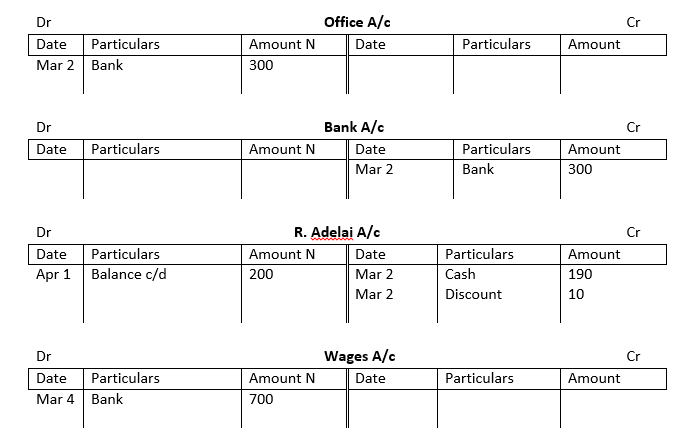

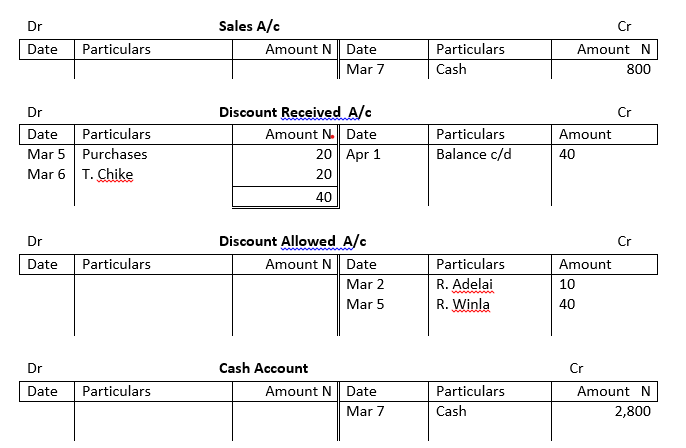
Further Explanations
1. Discount Received: This is the cash rebate given to the seller by his suppliers of goods. It is recorded on the credit side of the cash book and on the debit side of the ledger
2. Discount Allowed: This is the cash rebate given to the buyers of goods by the seller. It is usually recorded on the debit side of the cash book and on the credit side of the ledger.
3. Contra Entries: the word contra is a Latin word meaning opposite. In some cases in business, there may be excess cash in hand which needs to be paid into the bank for official use. These are known as contra entries because both sides of the cash book will have entries concerning each transaction. Contra entries are denoted by “c” or “cc” in the folio columns and on the ledger. A bank that is credited in the cash book will be debited, while cash debited on the cash book will be credited.
EVALUATION
Objectives:
1. ___________ is not a column in the ledger. (a) Date B. Folio C. Cash
2. _________ is a column for entering page numbers. A. Particulars B. Folio C. Discount
3. The debit side of the ledger is at the _______ A. left-hand side B. right-hand side C. centre side
4. The column used for recording the actual monetary value is called ______ A. folio B. discount C. Amount
Theory:
1. Define Ledger
2. List four items posted on the debit side of a ledger
Record the following in the appropriate ledger account of Tochukwu Nwufo:
2. a. Folio 28
Jan 1 he owed the business N2000
Jan 10 he was goods worth N3,500
Jan 15 he paid N4,000 cash to the business
Jan 22, receive a debt note of N550
Jan 25 receive a credit note of N150
Topic: Book Keeping - Ledger Entries
PREVIEW
1. Book keeping – Ledger Entries: ledger, meaning of ledger,
2. Items on a ledger – date, particulars, folio, Discount – amount,
3. How to record cash received/payments: discount received, discount allowed and contra entries
Full Content
Meaning of Ledger:
A ledger is the principal book of account where all accounting entries are recorded. It usually has numbered pages to enable it to be easily identified from other book of account. Each page is called a Folio, and the number in it is called Folio number. A Ledge is drawn as follows:
ITEMS ON A LEDGER/LEDGER ENTRIES

1. Date: this column is for recording the day, mount and year the transaction took place
2. Particulars: this column explains the type of transaction that took place, e. g sales, purchase and name of individual that is involved in the transaction
3. Folio: this column is used in entering the page number of the journal from which from which the posting to the ledger account is made
4. Discount: this column is for entering the discount received for proper reconciliation when cost is being calculated.
5. Amount: this column is used to record the actual monetary value in Naira and Kobo.
HOW TO RECORD CASH RECEIVED/PAYMENT
EXAMPLE: If Mr. Hassan made the following transactions, they will be posted in a three – column cash book:

From Mr. Hassan’s Cash Book, the following ledgers can be drawn:



Further Explanations
1. Discount Received: This is the cash rebate given to the seller by his suppliers of goods. It is recorded on the credit side of the cash book and on the debit side of the ledger
2. Discount Allowed: This is the cash rebate given to the buyers of goods by the seller. It is usually recorded on the debit side of the cash book and on the credit side of the ledger.
3. Contra Entries: the word contra is a Latin word meaning opposite. In some cases in business, there may be excess cash in hand which needs to be paid into the bank for official use. These are known as contra entries because both sides of the cash book will have entries concerning each transaction. Contra entries are denoted by “c” or “cc” in the folio columns and on the ledger. A bank that is credited in the cash book will be debited, while cash debited on the cash book will be credited.
EVALUATION
Objectives:
1. ___________ is not a column in the ledger. (a) Date B. Folio C. Cash
2. _________ is a column for entering page numbers. A. Particulars B. Folio C. Discount
3. The debit side of the ledger is at the _______ A. left-hand side B. right-hand side C. centre side
4. The column used for recording the actual monetary value is called ______ A. folio B. discount C. Amount
Theory:
1. Define Ledger
2. List four items posted on the debit side of a ledger
Record the following in the appropriate ledger account of Tochukwu Nwufo:
2. a. Folio 28
Jan 1 he owed the business N2000
Jan 10 he was goods worth N3,500
Jan 15 he paid N4,000 cash to the business
Jan 22, receive a debt note of N550
Jan 25 receive a credit note of N150
WEEK 4
LESSON 5
CASH BOOK
PREVIEW
(a) Meaning of Cash Book
(b) Types of Cash Book: Single Column cash book, Double Column Cash Book.
(c) Items on a column cash book: Cash column, Bank Column and discount column
(d) Preparation of Cash Book
Meaning of Cash Book
A Cash book is a book of account for recording cash receipts and cash payments. A Cash Book is one of the most important books of account. It is used only for recording cash transaction. A cash book, apart from the ledger is also a book of original entry.
Rules for Making Entries in the Cash Book
When making entries in the cash book, the following rules should be followed:
1. Enter all cash received on the debit side of the cash book.
2. Enter all cash paid out on the credit side of the cash book.
3. Enter the name of the receiver and the payer in the particular’s column
Types of Cash Book
There are three types of Cash Book
a. Single Column Cash Book
b. Double Column Cash Book
c. Three-Column Cash Book
We shall discuss each of these in detail:
Single Column Cash Book
The single Column Cash Book is drawn as follows:

It can be seen that Cash Book is divided into two equal parts, namely: the Debit side and the Credit side.
An Example is given below:
Mr. Akubo commenced business as a petty trade in Lagos, on 1st of March, 2011 with N8000 in cash. During the month, the following transactions took place: N
1. Mar. Bought office furniture 400.00
3 Mar. Bought assorted goods for sale 2000.00
5 Mar. Bought postage stamps 10.00
7 Mar. Sold goods for cash 80.00
8 Mar. Paid for cleaning materials 10.00
10 Mar. Received cash from Danladi Abubakar 50.00
14 Mar. Paid Adewale Adewunmi 90.00
16 Mar. Bought Stationery for cash 5.00
18 Mar. Bought sundry articles for resale 500.00
20 Mar. Received cash from Mallam Lamido 100.00
22. Mar. Cash Sales 50.00
24. Mar. Paid Jemima Johnson Cash 100.00
28 Mar. Paid wages to assistant 100.00
30 Mar. Paid rent 50.00
You are required to post the above entries to the cash book.
SOLUTION
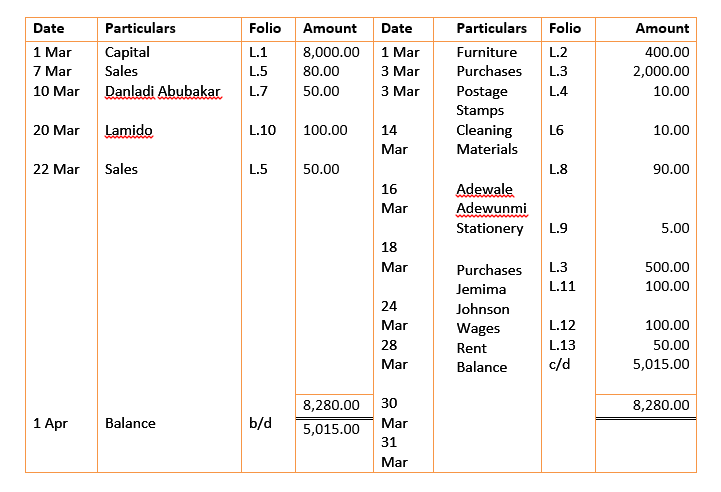
Two-Column Cash Book
A two-column cash book is used for recording a combination of bank and cash transactions. It has one column for each of cash and bank transactions on both debit and credit sides. It is drawn as follows:
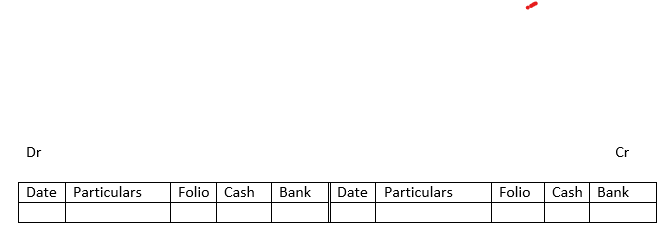
Rules for Making Entries in the Two-Column Cash Book
Sometimes money is taken from the bank to a cash box in an office or shop. At other times, cash is taken from the office or shop and paid into the bank. Such transfer is called Contra Entry. They must be recorded in book accounts: cash and Bank accounts. Contra Entry is denoted with ‘cc’. The word ‘Contra’ is Latin word which means ‘opposite’
For example, when money is transferred from the cash box in an office, the bank receives the money, and is therefore debited, the cash account which gives the money, must also be credited.
Example:
Enter the following transactions in a double –column cash book of Olorunfemi Enterprises from the following particulars:

Olorunfemi Enterprises Cash Book for May
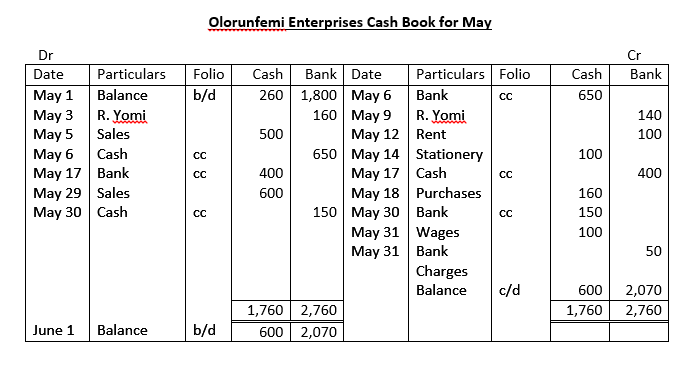
The Three Column Cash Book
The three column cash book is the same with the two-column cash book but with an additional column for discounts on both sides of the account.

Rules for Making Entries in the Two-Column Cash Book
The Discount column in the debit side records discount allowed to customers by the organization while the credit side records discount received by the organization.
Example: Record the following transactions in a three column cash book
N
Sept 1 Cash in Hand 500.00
Sept. 2 Received cheque from Joe 8,000.00
Sept. 2 Allowed Joe Discount 200.00
Sept. 4 Drew Cheque for Peter 2,200.00
Sept. 4 Received discount from Peter 400.00
Sept. 16 Bought goods in cash 250.00
Sept. 20 Received cash from Evans 4,000.00
Sept. 25 Paid Cash to Udoh 500.00
Sept. 30 Drew cheque for trade expenses 1,200.00
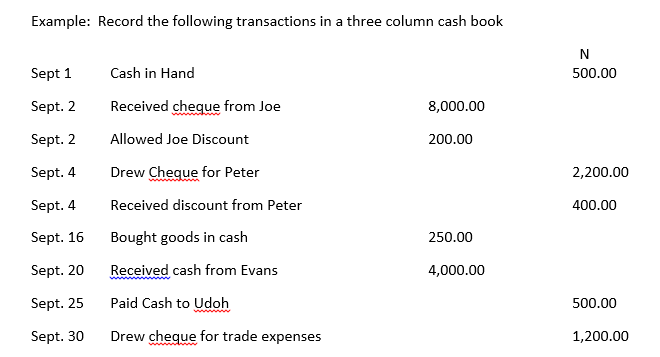
Workings
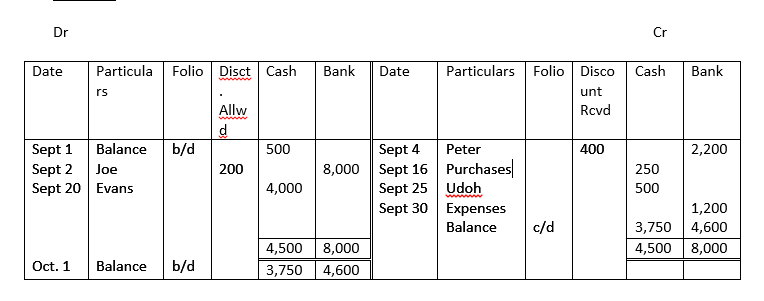
Evaluation:
Objectives:
1. A single-column cash book contains the following except: A. Date B. Bank C. Folio
2. Which of the following form of cash book does not exist? A. Single-Column cash book b. Double Column cash book c. Four-column Cash book.
3. The inducement given to a customer to encourage prompt payment is called______ A. cash discount B. Cash encouragement C. Trade discount
Theory:
Madam Adule commenced business on
June 1 With Cash 10,000.00
June 1 Paid to Bank 5,000.00
June 2 Bought goods with cash 3,000.00
June 10 Received cash from Ebuka 1,700.00
June 12 Bought Office Furniture 200.00
June 15 Paid Mr Aloba Aloe 340.00
Discount allowed by Aloba 20.00
June 20 Paid Tete Dimka 200.00
You are required to prepare Madam Adule’s Cash Book as at 30th June.
CASH BOOK
PREVIEW
(a) Meaning of Cash Book
(b) Types of Cash Book: Single Column cash book, Double Column Cash Book.
(c) Items on a column cash book: Cash column, Bank Column and discount column
(d) Preparation of Cash Book
Meaning of Cash Book
A Cash book is a book of account for recording cash receipts and cash payments. A Cash Book is one of the most important books of account. It is used only for recording cash transaction. A cash book, apart from the ledger is also a book of original entry.
Rules for Making Entries in the Cash Book
When making entries in the cash book, the following rules should be followed:
1. Enter all cash received on the debit side of the cash book.
2. Enter all cash paid out on the credit side of the cash book.
3. Enter the name of the receiver and the payer in the particular’s column
Types of Cash Book
There are three types of Cash Book
a. Single Column Cash Book
b. Double Column Cash Book
c. Three-Column Cash Book
We shall discuss each of these in detail:
Single Column Cash Book
The single Column Cash Book is drawn as follows:

It can be seen that Cash Book is divided into two equal parts, namely: the Debit side and the Credit side.
An Example is given below:
Mr. Akubo commenced business as a petty trade in Lagos, on 1st of March, 2011 with N8000 in cash. During the month, the following transactions took place: N
1. Mar. Bought office furniture 400.00
3 Mar. Bought assorted goods for sale 2000.00
5 Mar. Bought postage stamps 10.00
7 Mar. Sold goods for cash 80.00
8 Mar. Paid for cleaning materials 10.00
10 Mar. Received cash from Danladi Abubakar 50.00
14 Mar. Paid Adewale Adewunmi 90.00
16 Mar. Bought Stationery for cash 5.00
18 Mar. Bought sundry articles for resale 500.00
20 Mar. Received cash from Mallam Lamido 100.00
22. Mar. Cash Sales 50.00
24. Mar. Paid Jemima Johnson Cash 100.00
28 Mar. Paid wages to assistant 100.00
30 Mar. Paid rent 50.00
You are required to post the above entries to the cash book.
SOLUTION

Two-Column Cash Book
A two-column cash book is used for recording a combination of bank and cash transactions. It has one column for each of cash and bank transactions on both debit and credit sides. It is drawn as follows:

Rules for Making Entries in the Two-Column Cash Book
Sometimes money is taken from the bank to a cash box in an office or shop. At other times, cash is taken from the office or shop and paid into the bank. Such transfer is called Contra Entry. They must be recorded in book accounts: cash and Bank accounts. Contra Entry is denoted with ‘cc’. The word ‘Contra’ is Latin word which means ‘opposite’
For example, when money is transferred from the cash box in an office, the bank receives the money, and is therefore debited, the cash account which gives the money, must also be credited.
Example:
Enter the following transactions in a double –column cash book of Olorunfemi Enterprises from the following particulars:

Olorunfemi Enterprises Cash Book for May

The Three Column Cash Book
The three column cash book is the same with the two-column cash book but with an additional column for discounts on both sides of the account.

Rules for Making Entries in the Two-Column Cash Book
The Discount column in the debit side records discount allowed to customers by the organization while the credit side records discount received by the organization.
Example: Record the following transactions in a three column cash book
N
Sept 1 Cash in Hand 500.00
Sept. 2 Received cheque from Joe 8,000.00
Sept. 2 Allowed Joe Discount 200.00
Sept. 4 Drew Cheque for Peter 2,200.00
Sept. 4 Received discount from Peter 400.00
Sept. 16 Bought goods in cash 250.00
Sept. 20 Received cash from Evans 4,000.00
Sept. 25 Paid Cash to Udoh 500.00
Sept. 30 Drew cheque for trade expenses 1,200.00

Workings

Evaluation:
Objectives:
1. A single-column cash book contains the following except: A. Date B. Bank C. Folio
2. Which of the following form of cash book does not exist? A. Single-Column cash book b. Double Column cash book c. Four-column Cash book.
3. The inducement given to a customer to encourage prompt payment is called______ A. cash discount B. Cash encouragement C. Trade discount
Theory:
Madam Adule commenced business on
June 1 With Cash 10,000.00
June 1 Paid to Bank 5,000.00
June 2 Bought goods with cash 3,000.00
June 10 Received cash from Ebuka 1,700.00
June 12 Bought Office Furniture 200.00
June 15 Paid Mr Aloba Aloe 340.00
Discount allowed by Aloba 20.00
June 20 Paid Tete Dimka 200.00
You are required to prepare Madam Adule’s Cash Book as at 30th June.
WEEK 5
LESSON 6
BOOK KEEPING: Petty Cash Book
Preview
1. Book keeping – petty cash book: meaning of petty cash book,
2. preparation of petty cash book,
3. Imprest system – petty cash, refinement and reimbursement.
PETTY CASH BOOK
This is used to record small expenses such as postage stamps, envelops, transport fares, newspapers, stationery and other small items needed in the office. The word ‘petty’ means small or unimportant. We cannot pay for them with cheques because they are too small. It is also a book of original entry and also a ledger account for petty cash. The cost of each of the small items is recorded in the petty cash book instead of the ledger. The total expenses are transferred to the ledger as a petty cash account.

Columns In a Petty Cash Book
DEBIT SIDE
1. Amount
2. Date
3. Particulars of expenses
4. Voucher number
5. Total amount
CREDIT SIDE
On the credit side we have the analysis of expenses of a ledger account. This has different columns for different expenses e. g stationery, postage, transport, etc.
Recording of Receipts and Payments in Petty Cash Book
1. The credit entry is made in the cash book
2. The debt entry is made in the petty cash book
3. The entries on the credit side of the petty cash book are first made in the total column and then, extended into the relevant expenses column,
4. The expenses columns have various headings for different expenses,
5. The last column of the petty cash book is known as a ledger account.
Preparation of a Petty Cash Book
Example
Record the following in the relevant columns of the petty cash book of Chillington, a sole proprietor.
Jan 1. Petty cashier received an Imprest amount of N2000
2 Paid for bus fare N200
4 Paid for postage N150
8 Paid for duplicating paper N300
12 Bought envelops N250
16 Paid Mr. Kalu N500
25 Bought office pins N100
26 Bought stamps N100
30 Paid taxi fare N200
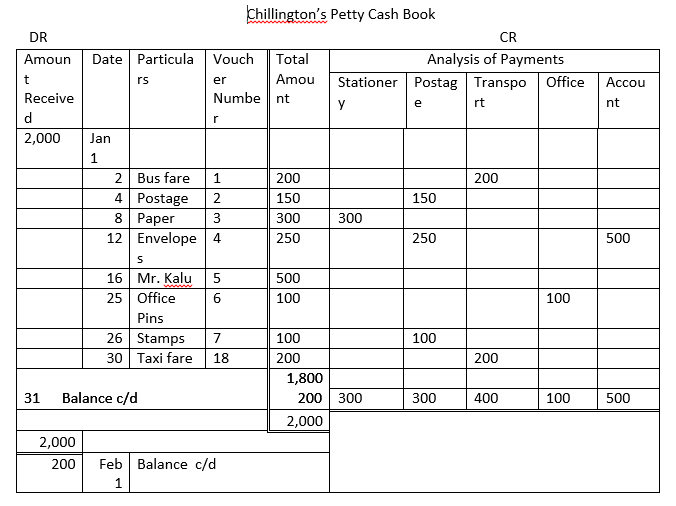
The above table is a petty cash book.
IMPREST SYSTEM
This is a method used in controlling the amount of money to the petty cashier. A fixed amount called Imprest is given to the cashier weekly or monthly to pay for small expenses.
At the end of the period, the petty cashier gives account of what she spends and the balance remaining. The amount spent will be reimbursed. This process of giving a petty cashier some amount of money for petty items at the beginning of every month is called “Imprest system”.
The sum of money giving to a petty cashier is called “Cash float”. Also, the document used in raising petty cash is known as a “Petty Cash Voucher”
Petty Cash
This is a small amount of discretionary funds in the form of cash used for expenditures where it is not sensible to make any disbursement by cheque, because of the inconvenience and costs of writing, signing and then cashing the cheque.
EVALUATION
Objectives:
1. _____________ is not found on the debit side of a petty cash book. A. Date given B. Voucher Number C. Total Amount
2. Which of the following expenditures can be paid from petty cash? A. Rent B. Equipment C. Stationery
3. The book where all small expenditure are recorded is called a __________ A. Ledger B. Petty cash book C. Journal
Theory:
A. What is a Petty Cash Book?
B. List three items contained in a petty cash book
C. State three advantages of a Petty Cash Book
BOOK KEEPING: Petty Cash Book
Preview
1. Book keeping – petty cash book: meaning of petty cash book,
2. preparation of petty cash book,
3. Imprest system – petty cash, refinement and reimbursement.
PETTY CASH BOOK
This is used to record small expenses such as postage stamps, envelops, transport fares, newspapers, stationery and other small items needed in the office. The word ‘petty’ means small or unimportant. We cannot pay for them with cheques because they are too small. It is also a book of original entry and also a ledger account for petty cash. The cost of each of the small items is recorded in the petty cash book instead of the ledger. The total expenses are transferred to the ledger as a petty cash account.

Columns In a Petty Cash Book
DEBIT SIDE
1. Amount
2. Date
3. Particulars of expenses
4. Voucher number
5. Total amount
CREDIT SIDE
On the credit side we have the analysis of expenses of a ledger account. This has different columns for different expenses e. g stationery, postage, transport, etc.
Recording of Receipts and Payments in Petty Cash Book
1. The credit entry is made in the cash book
2. The debt entry is made in the petty cash book
3. The entries on the credit side of the petty cash book are first made in the total column and then, extended into the relevant expenses column,
4. The expenses columns have various headings for different expenses,
5. The last column of the petty cash book is known as a ledger account.
Preparation of a Petty Cash Book
Example
Record the following in the relevant columns of the petty cash book of Chillington, a sole proprietor.
Jan 1. Petty cashier received an Imprest amount of N2000
2 Paid for bus fare N200
4 Paid for postage N150
8 Paid for duplicating paper N300
12 Bought envelops N250
16 Paid Mr. Kalu N500
25 Bought office pins N100
26 Bought stamps N100
30 Paid taxi fare N200

The above table is a petty cash book.
IMPREST SYSTEM
This is a method used in controlling the amount of money to the petty cashier. A fixed amount called Imprest is given to the cashier weekly or monthly to pay for small expenses.
At the end of the period, the petty cashier gives account of what she spends and the balance remaining. The amount spent will be reimbursed. This process of giving a petty cashier some amount of money for petty items at the beginning of every month is called “Imprest system”.
The sum of money giving to a petty cashier is called “Cash float”. Also, the document used in raising petty cash is known as a “Petty Cash Voucher”
Petty Cash
This is a small amount of discretionary funds in the form of cash used for expenditures where it is not sensible to make any disbursement by cheque, because of the inconvenience and costs of writing, signing and then cashing the cheque.
EVALUATION
Objectives:
1. _____________ is not found on the debit side of a petty cash book. A. Date given B. Voucher Number C. Total Amount
2. Which of the following expenditures can be paid from petty cash? A. Rent B. Equipment C. Stationery
3. The book where all small expenditure are recorded is called a __________ A. Ledger B. Petty cash book C. Journal
Theory:
A. What is a Petty Cash Book?
B. List three items contained in a petty cash book
C. State three advantages of a Petty Cash Book
WEEK 6
LESSON 7
PITMAN SHORTHAND (VOWEL PLACEMENT) FIRST, SECOND AND THIRD
PREVIEW
I. Vowels Placement(first, second and third),
II. Types of vowels(e,e,o, and u),
III. word drills
In J.S. One, we learnt that Shorthand is an art of representing spoken words by written signs. In other words, words are written as they sound and not how they are spelt
Vowels, in Shorthand, are written in different positions of an outline. The position of any vowel determines the sound of the outline. It enables one to know whether an outline is a first place outline or a third place outline. You will remember that a vowel can be placed at the beginning, middle and at the end of a stroke, as illustrated thus:
……………… First Place (at the Beginning of the stroke)
………… Second Place (at the middle of the stroke)
……. Third Place (At the end of the stroke)

First place Vowel
When a first place vowel is the first vowel in a word, the outline is written in the first place position, that is the first downstroke or upstroke is written above the line. Then the vowels are written at the beginning of the stroke.
Example: Long vowel /ah/ is represented by a heavy dot.
.

Second Place Vowel
When a second place vowel is the first vowel in a word, the outline is written in the second position, that is the first down stroke or upstroke rests on the line. Then the vowels are written at the middle of the outline or stroke.
Example:
 .
.
Third Place Vowel
When a third place vowel is the first vowel in a word, the outline is written in third place position, that is the first downstroke or upstroke is written through the line.
When a third place vowel comes between two strokes, it is put in the third place before the second stroke.
Example:

Types of Vowels
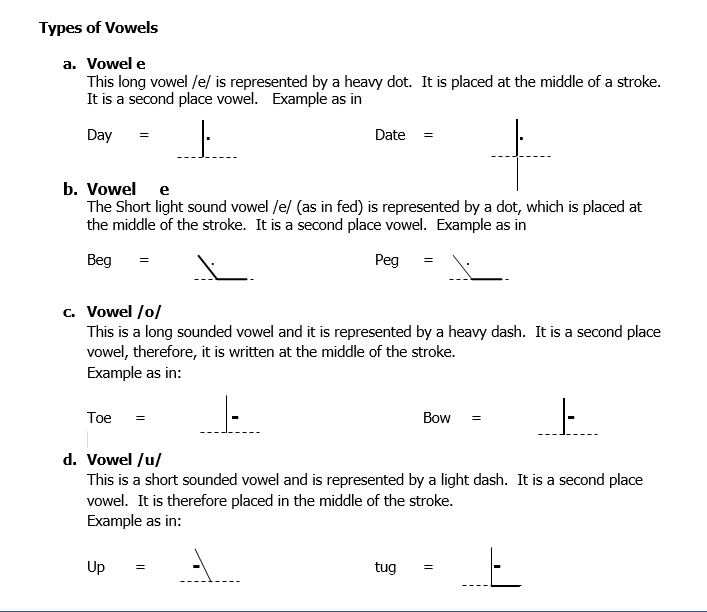
EVALUATION
Objectives:
1. Third place vowels are placed at the……………………. A. Beginning B. Bottom C. Side
2. Vowels are placed on the ……………….. A. Signs B. Sounds C. Strokes
3. Vowel ‘e’ is represented with a ---------- (a) light dot (b) light dash (c) heavy dot
4. In a word like cup, the ‘u’ is represented with a ------- (a) light dot (b) light dash (c) heavy dash
Theory:
1. Transcribe the following: pay, palm, calm, take, date, bay, Edet
2. What happen when a vowel comes before the stroke, where is it written?
3. Where is the second place vowel written?
LESSON 8
Pitman Shorthand (Third group of consonants and vowels)
PREVIEW
1. Consonants and Vowels – Third group of consonants ( k, g m, n, ng, I , w, y),
2. First place Vowels(ah, oo, aw)
3. Third place Vowels ( e, I, oo, oo)
Third group of consonants
The third group of Shorthand Consonants is K, G, M, N, Ng, L, W and Y. They are represented by horizontal strokes and curves. One thing is common to these consonants, they are all written forward

Word Drills
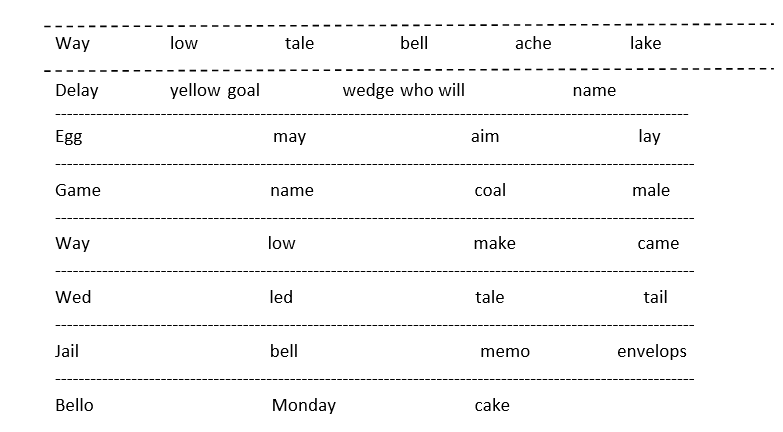
First Place Vowels
The first place vowels are written in the first place, i.e. at the beginning of a stroke. When a first place vowel is the first vowel in a word, the outline is written in the first place position, that is the first downstroke or upstroke is written above the line.
The vowels are:
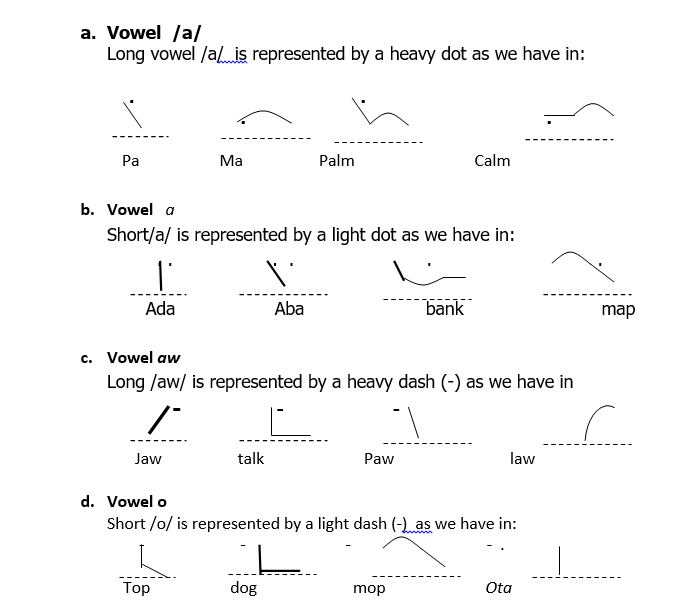
Third Place Vowels
The third place vowels are four in number. Remember that third place outlines or strokes are written through the line.
The vowels are:

EVALUATION
Objectives:
1. The third group of consonants are ……………… strokes a. Horizontal and light b. curved and heavy c. horizontal and curved.
2. In using a second place vowel, the strokes must be written _________
a. Above the line b. on the line c. through the line
3. Thick and thin strokes are used to represent ……………………. A. consonants b. vowels c. Phrases
Theory:
1. Write these words in shorthand: lake, goal, came, pit, tale, lick, kill, Bell
2. Shock, church, lunch, gang, ship
LESSON 9
Pitman Shorthand (Consonants R & H)
PREVIEW
1. Consonants and Vowels – The fourth last group of consonants ( R & H),
2. Forems or R and H -Upward, downward.
3. Diphthongs and triphone -meaning
4. Shorthand outlines and signs
Consonants /r/ and /h/ are the fourth group of Shorthand consonants because they have two different ways of representing them.
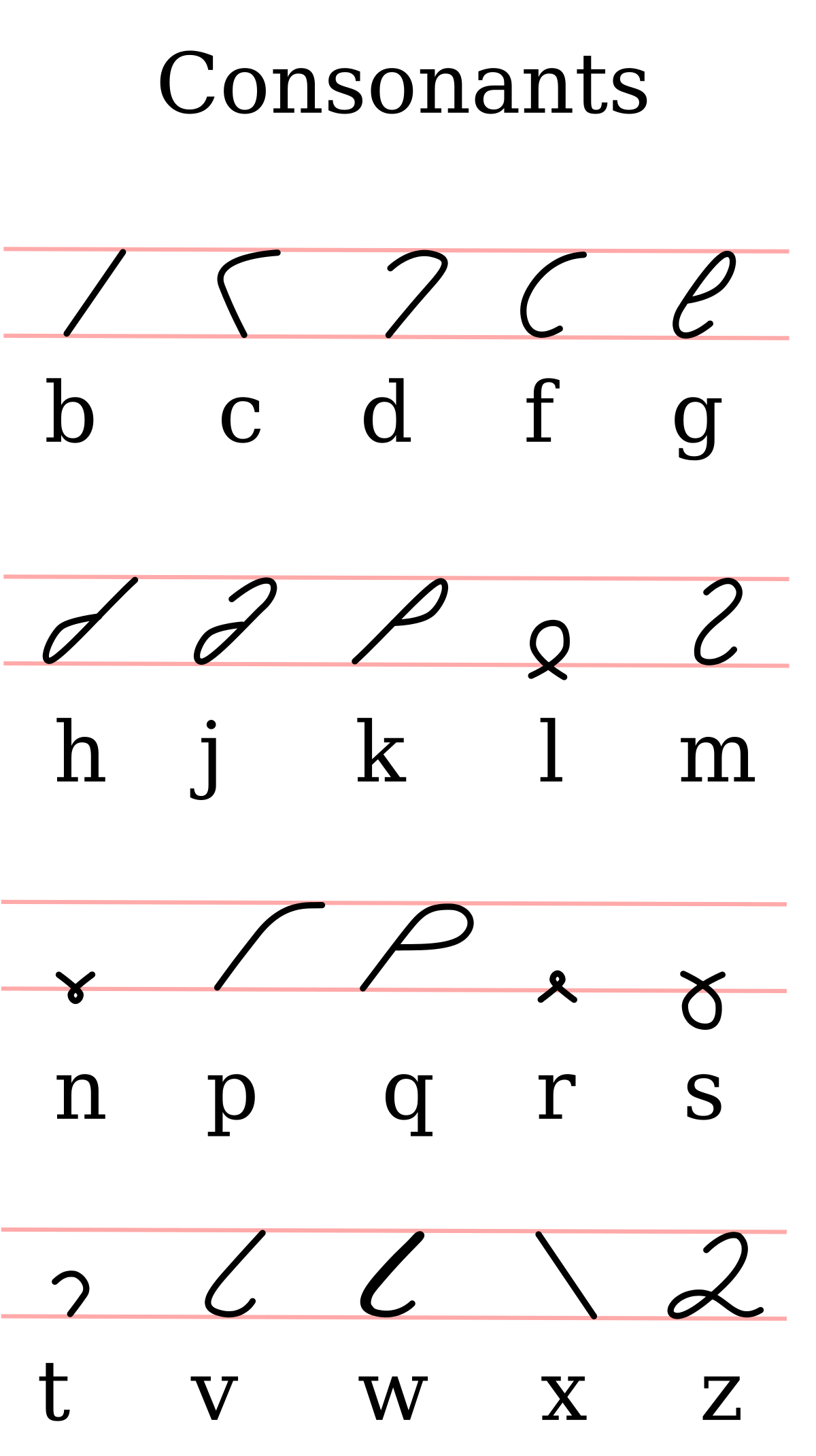
There is the upward /r/ and /h/, and also downward /r/ and /h/.
Upward R .
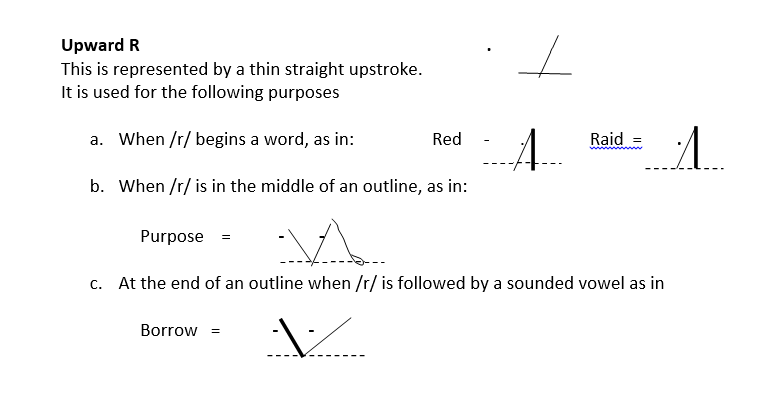
Downward R
Downward /r/ is a thin curve down stroke. It is used:
a. when a vowel comes before /r/ at the beginning of a word, as in
air, her, erase, earth
b. When /r/ ends a word, as in:
Care, dare, error
c. When /r/ comes before /m/, as in:
Rome, term, firm
Downward H
Downward H is usually represented by a downward stroke.
It is used when /g/ is the only consonant or if it is followed by /k/ or /g/, as in:
High, hake, hug
Upward H
This is usually represented by an upward stroke. It is used when joining /h/ to other consonants, as in:
Happy, hope, head, hero, etc.
Diphthong
This is described as two vowels being pronounced as one syllable. There are four types of this shorthand: /i/, /o/, /ow/ and /u/
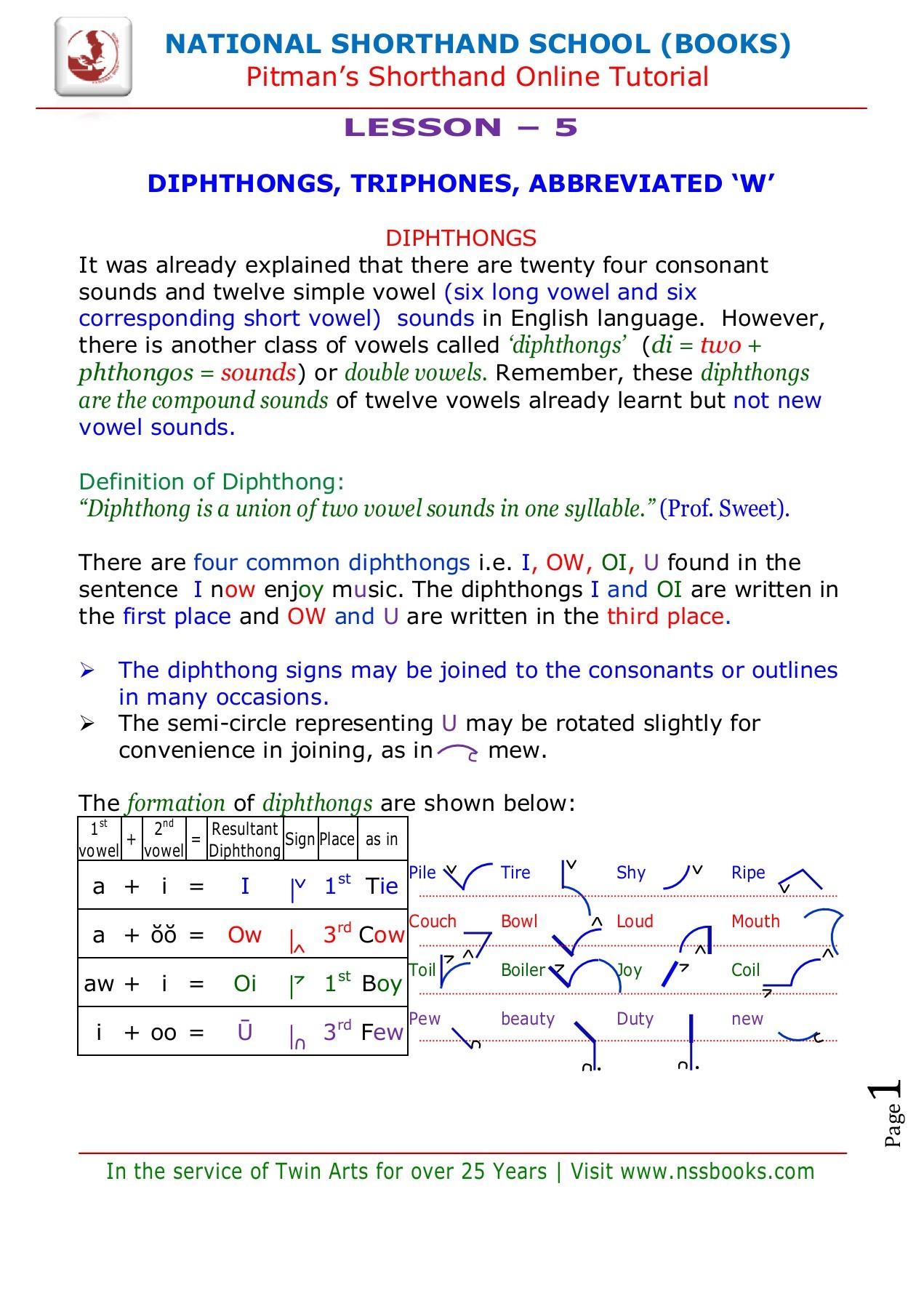

Diphthong /i/ and /oi/ are first place vowel placements.
The sign for /i/ is __________
Example: Pie ________ Buy __________
Die _________ tie __________
The sign for /oi/ is ______
Example: Boy ________ Toy __________
The Diphthong /ow/ and /u/ are third place vowel placements.
The sign for /ow/ is ______
Example: Cow _________ Out _________
Loud __________ row
The sign for /u/ is ________
Example: duty ________ cure _________
The Triphone
A small tick added to the diphthong sign shows that another vowel immediately follows the diphthong.
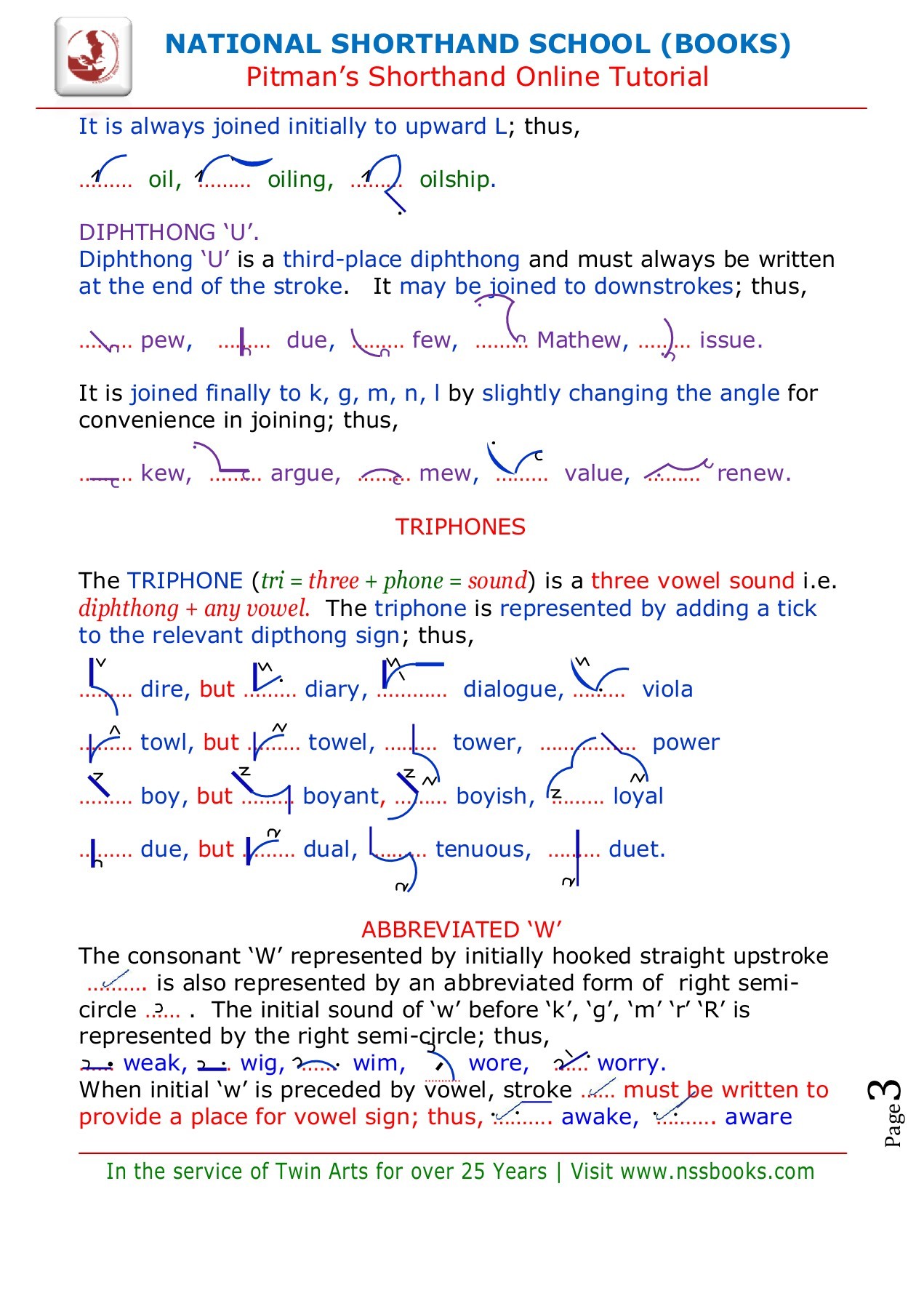
This combination is called Triphone. Therefore, a triphone is a combination of three vowels as in:
Buyer ________ Royal _________ Liar ___________
Via _________ Loyal_________ Power _________
Evaluation:
1. Write the following in Shorthand: Red, Raid, Purpose, burrow, care, dare, door, error, Rome, Room
2. Transcribe the following into Shorthand: Happy, Hero, hurry, home, health
PITMAN SHORTHAND (VOWEL PLACEMENT) FIRST, SECOND AND THIRD
PREVIEW
I. Vowels Placement(first, second and third),
II. Types of vowels(e,e,o, and u),
III. word drills
In J.S. One, we learnt that Shorthand is an art of representing spoken words by written signs. In other words, words are written as they sound and not how they are spelt
Vowels, in Shorthand, are written in different positions of an outline. The position of any vowel determines the sound of the outline. It enables one to know whether an outline is a first place outline or a third place outline. You will remember that a vowel can be placed at the beginning, middle and at the end of a stroke, as illustrated thus:
……………… First Place (at the Beginning of the stroke)
………… Second Place (at the middle of the stroke)
……. Third Place (At the end of the stroke)

First place Vowel
When a first place vowel is the first vowel in a word, the outline is written in the first place position, that is the first downstroke or upstroke is written above the line. Then the vowels are written at the beginning of the stroke.
Example: Long vowel /ah/ is represented by a heavy dot.
.

Second Place Vowel
When a second place vowel is the first vowel in a word, the outline is written in the second position, that is the first down stroke or upstroke rests on the line. Then the vowels are written at the middle of the outline or stroke.
Example:
 .
. Third Place Vowel
When a third place vowel is the first vowel in a word, the outline is written in third place position, that is the first downstroke or upstroke is written through the line.
When a third place vowel comes between two strokes, it is put in the third place before the second stroke.
Example:

Types of Vowels

EVALUATION
Objectives:
1. Third place vowels are placed at the……………………. A. Beginning B. Bottom C. Side
2. Vowels are placed on the ……………….. A. Signs B. Sounds C. Strokes
3. Vowel ‘e’ is represented with a ---------- (a) light dot (b) light dash (c) heavy dot
4. In a word like cup, the ‘u’ is represented with a ------- (a) light dot (b) light dash (c) heavy dash
Theory:
1. Transcribe the following: pay, palm, calm, take, date, bay, Edet
2. What happen when a vowel comes before the stroke, where is it written?
3. Where is the second place vowel written?
LESSON 8
Pitman Shorthand (Third group of consonants and vowels)
PREVIEW
1. Consonants and Vowels – Third group of consonants ( k, g m, n, ng, I , w, y),
2. First place Vowels(ah, oo, aw)
3. Third place Vowels ( e, I, oo, oo)
Third group of consonants
The third group of Shorthand Consonants is K, G, M, N, Ng, L, W and Y. They are represented by horizontal strokes and curves. One thing is common to these consonants, they are all written forward

Word Drills

First Place Vowels
The first place vowels are written in the first place, i.e. at the beginning of a stroke. When a first place vowel is the first vowel in a word, the outline is written in the first place position, that is the first downstroke or upstroke is written above the line.
The vowels are:

Third Place Vowels
The third place vowels are four in number. Remember that third place outlines or strokes are written through the line.
The vowels are:

EVALUATION
Objectives:
1. The third group of consonants are ……………… strokes a. Horizontal and light b. curved and heavy c. horizontal and curved.
2. In using a second place vowel, the strokes must be written _________
a. Above the line b. on the line c. through the line
3. Thick and thin strokes are used to represent ……………………. A. consonants b. vowels c. Phrases
Theory:
1. Write these words in shorthand: lake, goal, came, pit, tale, lick, kill, Bell
2. Shock, church, lunch, gang, ship
LESSON 9
Pitman Shorthand (Consonants R & H)
PREVIEW
1. Consonants and Vowels – The fourth last group of consonants ( R & H),
2. Forems or R and H -Upward, downward.
3. Diphthongs and triphone -meaning
4. Shorthand outlines and signs
Consonants /r/ and /h/ are the fourth group of Shorthand consonants because they have two different ways of representing them.

There is the upward /r/ and /h/, and also downward /r/ and /h/.
Upward R .

Downward R
Downward /r/ is a thin curve down stroke. It is used:
a. when a vowel comes before /r/ at the beginning of a word, as in
air, her, erase, earth
b. When /r/ ends a word, as in:
Care, dare, error
c. When /r/ comes before /m/, as in:
Rome, term, firm
Downward H
Downward H is usually represented by a downward stroke.
It is used when /g/ is the only consonant or if it is followed by /k/ or /g/, as in:
High, hake, hug
Upward H
This is usually represented by an upward stroke. It is used when joining /h/ to other consonants, as in:
Happy, hope, head, hero, etc.
Diphthong
This is described as two vowels being pronounced as one syllable. There are four types of this shorthand: /i/, /o/, /ow/ and /u/


Diphthong /i/ and /oi/ are first place vowel placements.
The sign for /i/ is __________
Example: Pie ________ Buy __________
Die _________ tie __________
The sign for /oi/ is ______
Example: Boy ________ Toy __________
The Diphthong /ow/ and /u/ are third place vowel placements.
The sign for /ow/ is ______
Example: Cow _________ Out _________
Loud __________ row
The sign for /u/ is ________
Example: duty ________ cure _________
The Triphone
A small tick added to the diphthong sign shows that another vowel immediately follows the diphthong.

This combination is called Triphone. Therefore, a triphone is a combination of three vowels as in:
Buyer ________ Royal _________ Liar ___________
Via _________ Loyal_________ Power _________
Evaluation:
1. Write the following in Shorthand: Red, Raid, Purpose, burrow, care, dare, door, error, Rome, Room
2. Transcribe the following into Shorthand: Happy, Hero, hurry, home, health
WEEK 7
LESSON 10
MAIN TOPIC: Shorthand (Revision)
SPECIFIC TOPIC: Introduction to Shorthand
REFERENCE BOOKS:
Macmillan JSS1 Business Studies by Awoyokun A.A et al .Pages 68-70
Pitman 2000 Shorthand first course by Pitman. Xi-xii
PERFORMANCE OBJECTIVES: At the end of the lesson, students should be able to:
Define shorthand
Trace the historical development of shorthand
CONTENTS:
Shorthand is a method of writing words quickly by means of signs.
Pitman shorthand was invented by Sir Isaac Pitman in the 19th century and was then known as the initial teaching alphabet.
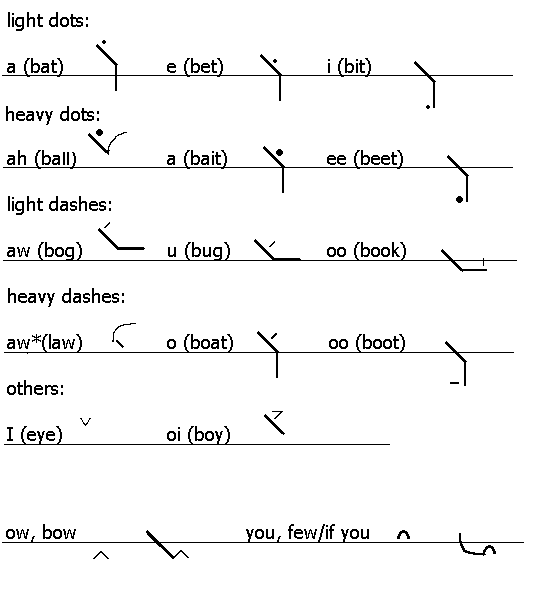
EVALUATION:
What is shorthand?
Briefly trace the historical development of shorthand.
HOME-WORK: Mention three advantages of shorthand.
SPECIFIC TOPIC: Advantages of shorthand
REFERENCE BOOKS:
Macmillan JSS1 Business Studies by Awoyokun A.A et al .Pages 71-72
Pitman 2000 Shorthand first course by Pitman. Pages 1-4
PERFORMANCE OBJECTIVES: At the end of the lesson, students should be able to:
mention advantages of shorthand
CONTENTS: ADVANTAGES OF SHORTHAND
Shorthand is a means of earning a living
It is a means of setting up ones private business
It helps to make accurate ,immediate and legible record of spoken words in parliaments etc
There is an improvement of the spoken and written form of English language.
EVALUATION:
Mention three advantages of shorthand
HOME-WORK: mention four techniques of writing good shorthand outline.
SPECIFIC TOPIC: Technique of writing good shorthand outline
REFERENCE BOOKS:
Macmillan JSS1 Business Studies by Awoyokun A.A et al .Pages 68-70
Pitman 2000 Shorthand first course by Pitman. Pages 1-4
PERFORMANCE OBJECTIVES: At the end of the lesson, students should be able to:
Mention the various techniques of writing good shorthand outline.
CONTENTS:
TECHNIQUES OF WRITING GOOD SHORTHAND OUTLINE
Provision of good shorthand writing material. This includes shorthand notebook, pen or pencil, and desk.
Good correct sitting position
There should be no erasure
Constant drilling is important
Memorizing of short form is also very important.
EVALUATION: Mention four techniques of writing good shorthand outline
HOME-WORK: What are short forms?
LESSON 11
SPECIFIC TOPIC: Introduction to first six consonants.
REFERENCE BOOKS:
Macmillan JSS1 Business Studies by Awoyokun A.A et al .Pages 71-72
Pitman 2000 Shorthand first course by Pitman. Pages 1-4
PERFORMANCE OBJECTIVES: At the end of the lesson, students should be able to:
mention the numbers of consonants in Pitman shorthand
distinguish between heavy and light strokes
write out possible consonants for P,B,T,D and vowels A and O.
CONTENTS:
Pitman shorthand alphabet comprises of 24 consonants, 12 vowels and 4 diphthongs.
Consonants are represented with strokes and curves, vowels are represented with dots and dashes while
diphthongs are represented with angular marks.
P is a thin stroke written downwards.
B is a thick stroke written downwards
T is a thin stroke written downward
D is a thick stroke written downwards.

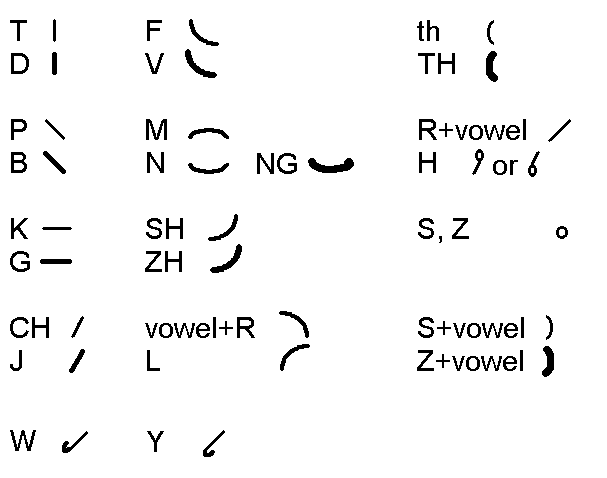
EVALUATION:
How many consonants do we have in Pitman shorthand?
Write the shorthand outline for P, B, T, and D.
Distinguish between heavy and light stokes.
HOME-WORK: How many vowels do we have in Pitman shorthand?
SPECIFIC TOPIC: Vowels
REFERENCE BOOKS:
Macmillan JSS1 Business Studies by Awoyokun A.A et al .Pages 71-72
Pitman 2000 Shorthand first course by Pitman. Pages 1-4
PERFORMANCE OBJECTIVES: At the end of the lesson, students should be able to:
mention the numbers of vowels in Pitman shorthand
mention and practice writing the six short vowels
mention and practice writing the six long vowels
mention the three placement of vowels
practice the joining of consonants.
CONTENTS:
There are 12 vowels in Pitman shorthand and they are represented with dots and dashes.
There are six short vowel sound represented by light dots and dashes.
Read More...
There are six long vowel sound represented by heavy dots and dashes.
ah ā ee aw ō oo
pa may we all go too
. . . - - -
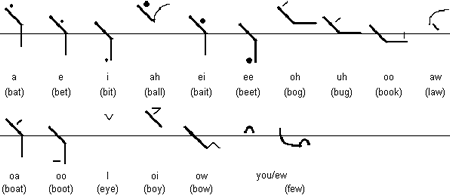
There are three places on a consonant where vowels may be placed.
These are:
The beginning or first place vowel-where the stroke begins
The middle or second place vowel - in the middle of the stroke
The third place vowel or the end vowel-at the end of the stoke.
EVALUATION:
How many vowels do we have in Pitman shorthand?
Write the shorthand outline for the 12 vowels in Pitman shorthand
Explain vowel placement in shorthand
HOME-WORK: What are shortforms?
LESSON 12
SPECIFIC TOPIC: Shortforms
REFERENCE BOOKS:
Macmillan JSS1 Business Studies by Awoyokun A.A et al .Pages 71-72
Pitman 2000 Shorthand first course by Pitman. Pages 1-4
PERFORMANCE OBJECTIVES: At the end of the lesson, students should be able to:
Define short forms
Define phrases
Memorize the first set of short forms, phrases and punctuations
CONTENTS:
SHORT FORMS
Short forms are special signs used to represent words that are frequently used in English language.
Short forms have to be memorized by constantly practicing them.
First set of short forms are:
. O
The it and is/his of to today
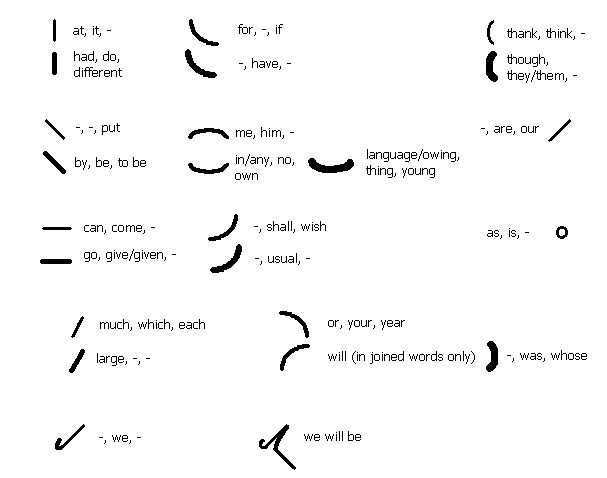
PHRASES
This is the joining of shorthand outlines together without lifting the pen, in order to increase our speed in shorthand writing.
.
Pay the
of the
date the

PUNCTUATION
This is the same in shorthand as in longhand except for:
Full stop
Dash
Question mark
Hypen

EVALUATION:
What is short form?
What are phrases?
What are the short forms for the following: it, today, the, of, and.
HOME-WORK: Join the following consonants: pd,td,pb,bd,tp,bt and drill several times.
SPECIFIC TOPIC: Introduction to consonants K, G, M, N, NG.
REFERENCE BOOKS:
Macmillan JSS2 Business Studies by Awoyokun A.A et al .Pages 59-61
Pitman 2000 Shorthand first course by Pitman. Pages 1-4
PERFORMANCE OBJECTIVES: At the end of the lesson, students should be able to:
Write the outlines of the following consonants correctly K, G, M, N, NG.
Drill some words that begin with the consonants
Distinguish the first set of consonants from the second group.
CONTENTS:
K (thin) G (thick)
M (thin and curve) N (thin and curve) ͜ NG (thick and curve) ͜
EVALUATION:
Write out the shorthand outline for K, G, M, N, NG.
What is/are the difference(s) between the first and second consonants
Write the following in shorthand ache, cake, may, no/know, oak, go, own
HOME-WORK: join the following consonants: PK, PM, DM, TK, TM, GP, CD,
Write the following words in shorthand: cape, makes, names, code, takes and dome.
Read More...
https://youtu.be/H7zLAhN_UU4
MAIN TOPIC: Shorthand (Revision)
SPECIFIC TOPIC: Introduction to Shorthand
REFERENCE BOOKS:
Macmillan JSS1 Business Studies by Awoyokun A.A et al .Pages 68-70
Pitman 2000 Shorthand first course by Pitman. Xi-xii
PERFORMANCE OBJECTIVES: At the end of the lesson, students should be able to:
Define shorthand
Trace the historical development of shorthand
CONTENTS:
Shorthand is a method of writing words quickly by means of signs.
Pitman shorthand was invented by Sir Isaac Pitman in the 19th century and was then known as the initial teaching alphabet.

EVALUATION:
What is shorthand?
Briefly trace the historical development of shorthand.
HOME-WORK: Mention three advantages of shorthand.
SPECIFIC TOPIC: Advantages of shorthand
REFERENCE BOOKS:
Macmillan JSS1 Business Studies by Awoyokun A.A et al .Pages 71-72
Pitman 2000 Shorthand first course by Pitman. Pages 1-4
PERFORMANCE OBJECTIVES: At the end of the lesson, students should be able to:
mention advantages of shorthand
CONTENTS: ADVANTAGES OF SHORTHAND
Shorthand is a means of earning a living
It is a means of setting up ones private business
It helps to make accurate ,immediate and legible record of spoken words in parliaments etc
There is an improvement of the spoken and written form of English language.
EVALUATION:
Mention three advantages of shorthand
HOME-WORK: mention four techniques of writing good shorthand outline.
SPECIFIC TOPIC: Technique of writing good shorthand outline
REFERENCE BOOKS:
Macmillan JSS1 Business Studies by Awoyokun A.A et al .Pages 68-70
Pitman 2000 Shorthand first course by Pitman. Pages 1-4
PERFORMANCE OBJECTIVES: At the end of the lesson, students should be able to:
Mention the various techniques of writing good shorthand outline.
CONTENTS:
TECHNIQUES OF WRITING GOOD SHORTHAND OUTLINE
Provision of good shorthand writing material. This includes shorthand notebook, pen or pencil, and desk.
Good correct sitting position
There should be no erasure
Constant drilling is important
Memorizing of short form is also very important.
EVALUATION: Mention four techniques of writing good shorthand outline
HOME-WORK: What are short forms?
LESSON 11
SPECIFIC TOPIC: Introduction to first six consonants.
REFERENCE BOOKS:
Macmillan JSS1 Business Studies by Awoyokun A.A et al .Pages 71-72
Pitman 2000 Shorthand first course by Pitman. Pages 1-4
PERFORMANCE OBJECTIVES: At the end of the lesson, students should be able to:
mention the numbers of consonants in Pitman shorthand
distinguish between heavy and light strokes
write out possible consonants for P,B,T,D and vowels A and O.
CONTENTS:
Pitman shorthand alphabet comprises of 24 consonants, 12 vowels and 4 diphthongs.
Consonants are represented with strokes and curves, vowels are represented with dots and dashes while
diphthongs are represented with angular marks.
P is a thin stroke written downwards.
B is a thick stroke written downwards
T is a thin stroke written downward
D is a thick stroke written downwards.


EVALUATION:
How many consonants do we have in Pitman shorthand?
Write the shorthand outline for P, B, T, and D.
Distinguish between heavy and light stokes.
HOME-WORK: How many vowels do we have in Pitman shorthand?
SPECIFIC TOPIC: Vowels
REFERENCE BOOKS:
Macmillan JSS1 Business Studies by Awoyokun A.A et al .Pages 71-72
Pitman 2000 Shorthand first course by Pitman. Pages 1-4
PERFORMANCE OBJECTIVES: At the end of the lesson, students should be able to:
mention the numbers of vowels in Pitman shorthand
mention and practice writing the six short vowels
mention and practice writing the six long vowels
mention the three placement of vowels
practice the joining of consonants.
CONTENTS:
There are 12 vowels in Pitman shorthand and they are represented with dots and dashes.
There are six short vowel sound represented by light dots and dashes.
Read More...
There are six long vowel sound represented by heavy dots and dashes.
ah ā ee aw ō oo
pa may we all go too
. . . - - -

There are three places on a consonant where vowels may be placed.
These are:
The beginning or first place vowel-where the stroke begins
The middle or second place vowel - in the middle of the stroke
The third place vowel or the end vowel-at the end of the stoke.
EVALUATION:
How many vowels do we have in Pitman shorthand?
Write the shorthand outline for the 12 vowels in Pitman shorthand
Explain vowel placement in shorthand
HOME-WORK: What are shortforms?
LESSON 12
SPECIFIC TOPIC: Shortforms
REFERENCE BOOKS:
Macmillan JSS1 Business Studies by Awoyokun A.A et al .Pages 71-72
Pitman 2000 Shorthand first course by Pitman. Pages 1-4
PERFORMANCE OBJECTIVES: At the end of the lesson, students should be able to:
Define short forms
Define phrases
Memorize the first set of short forms, phrases and punctuations
CONTENTS:
SHORT FORMS
Short forms are special signs used to represent words that are frequently used in English language.
Short forms have to be memorized by constantly practicing them.
First set of short forms are:
. O
The it and is/his of to today

PHRASES
This is the joining of shorthand outlines together without lifting the pen, in order to increase our speed in shorthand writing.
.
Pay the
of the
date the

PUNCTUATION
This is the same in shorthand as in longhand except for:
Full stop
Dash
Question mark
Hypen

EVALUATION:
What is short form?
What are phrases?
What are the short forms for the following: it, today, the, of, and.
HOME-WORK: Join the following consonants: pd,td,pb,bd,tp,bt and drill several times.
SPECIFIC TOPIC: Introduction to consonants K, G, M, N, NG.
REFERENCE BOOKS:
Macmillan JSS2 Business Studies by Awoyokun A.A et al .Pages 59-61
Pitman 2000 Shorthand first course by Pitman. Pages 1-4
PERFORMANCE OBJECTIVES: At the end of the lesson, students should be able to:
Write the outlines of the following consonants correctly K, G, M, N, NG.
Drill some words that begin with the consonants
Distinguish the first set of consonants from the second group.
CONTENTS:
K (thin) G (thick)
M (thin and curve) N (thin and curve) ͜ NG (thick and curve) ͜
EVALUATION:
Write out the shorthand outline for K, G, M, N, NG.
What is/are the difference(s) between the first and second consonants
Write the following in shorthand ache, cake, may, no/know, oak, go, own
HOME-WORK: join the following consonants: PK, PM, DM, TK, TM, GP, CD,
Write the following words in shorthand: cape, makes, names, code, takes and dome.
Read More...
https://youtu.be/H7zLAhN_UU4
WEEK 8
LESSON 13
MAIN TOPIC: Shorthand Consonants
SPECIFIC TOPIC: DOT ING
REFERENCE BOOKS:
Macmillan JSS1 Business Studies by Awoyokun A.A et al .Pages 71-72
Pitman 2000 Shorthand first course by Pitman. Pages 1-4
PERFORMANCE OBJECTIVES: At the end of the lesson, students should be able to:
Recognize and write the outline for DOT ING
Write more words in shorthand
CONTENTS:
A dot at the end of the last stroke of an outline represents the suffix ING. Write the stroke out first, then the dot ING and the vowel sign last.
Examples:
̇ .
Coping ̇ going dating
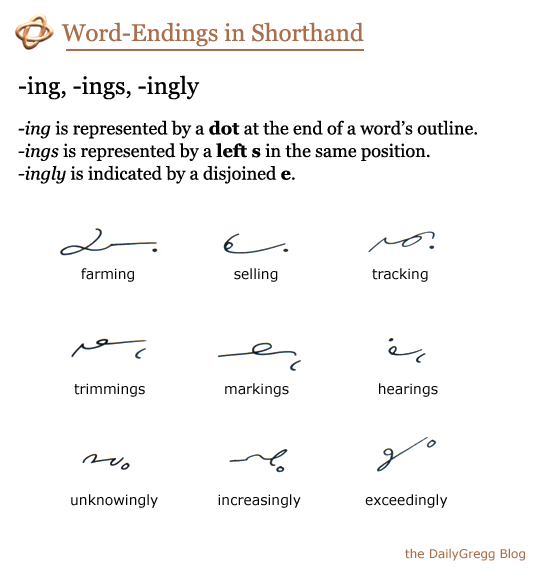
Read More...
EVALUATION:
What is the outline for dot ING?
Write the following words in shorthand: aiming, knowing, paying, staying, taking, making, naming.
HOME-WORK: What are the short forms of the following? Doing, nothing, in his etc.
SPECIFIC TOPIC: Second Set of Short Forms
REFERENCE BOOKS:
Macmillan JSS1 Business Studies by Awoyokun A.A et al .Pages 71-72
Pitman 2000 Shorthand first course by Pitman. Pages 1-4
PERFORMANCE OBJECTIVES: At the end of the lesson, students should be able to:
Define derivatives
Memorize the second set of short forms and phrases
CONTENTS:
SHORT FORMS
Derivative is a term used for a word built from another word called the root word.
E.g. any is a root word, anything is a derivative
second set of short forms are:
͜
I/eye .doing in/any etc

PHRASES
͜
I do in the etc
EVALUATION:
What is derivative?
Give five examples each of root word and derivatives.
What are the short forms for the following: its, nothing, you
HOME-WORK: what are the outlines for the following consonants: F, V, Th
LESSON 14
MAIN TOPIC: Shorthand Consonants
SPECIFIC TOPIC: Introduction to consonants F, V, Th, TH, SES, SEZ, ZEZ
REFERENCE BOOKS:
Pitman 2000 Shorthand first course by Pitman. Pages 1-4
PERFORMANCE OBJECTIVES: At the end of the lesson, students should be able to:
Write the outlines of the following consonants correctly F,V, TH, Th
Drill some words that begin with the consonants
Distinguish the third set of consonants from the other groups.
CONTENTS:
F is a thin, curved downstroke
V is a thick, downstroke
Th (as in faith) is a thin curved downstroke
TH (as in they) is a thick , curved downstroke
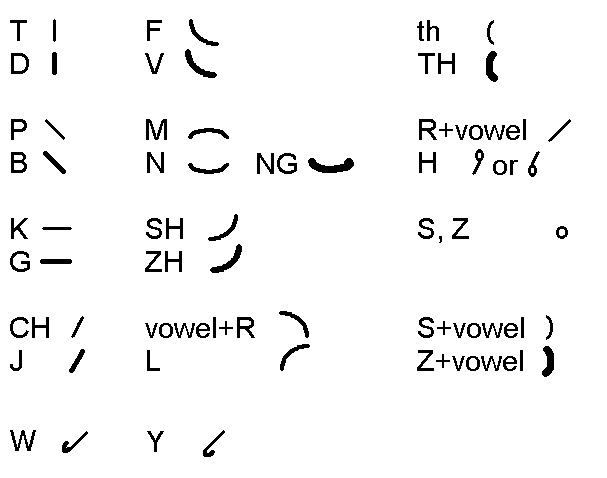
EVALUATION:
Write out the shorthand outline for F,V, TH, Th
What is/are the difference(s) between these set of consonants and others.
Write the following in shorthand foe, fade, fake, folk, foam, photos
HOME-WORK: Write the following words in shorthand: bases, cases, gazes
MAIN TOPIC: Shorthand Consonants
SPECIFIC TOPIC: SES, SEZ, ZES, ZEZ
REFERENCE BOOKS:
Pitman 2000 Shorthand first course by Pitman. Pages 1-4
PERFORMANCE OBJECTIVES: At the end of the lesson, students should be able to:
Recognize and write the outline of words that ends with SES, SEZ, ZES, ZEZ
Write more words in shorthand
CONTENTS:
The sound of SES, SEZ, ZES, ZEZ at the end of a word is represented by a large circle written at the end of an outline and is read last.
The circle SEZ must be larger than the circle
Examples: bases .
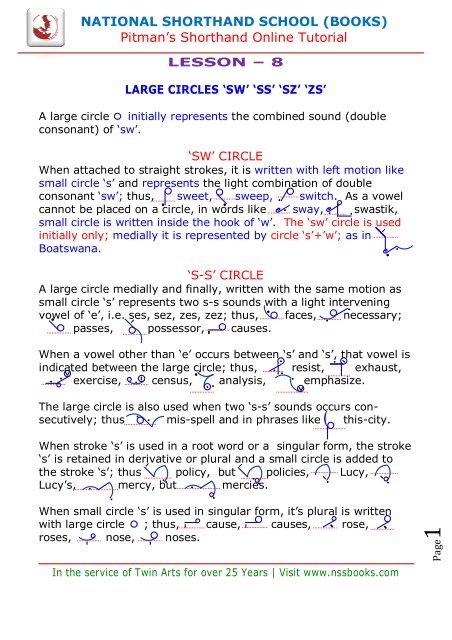
EVALUATION:
Write the following words in shorthand: bet, betting, eggs, guessing, memo, memos
HOME-WORK: What are the short forms of the following? For, have, be, this, all
MAIN TOPIC: Shorthand Consonants
SPECIFIC TOPIC: DOT ING
REFERENCE BOOKS:
Macmillan JSS1 Business Studies by Awoyokun A.A et al .Pages 71-72
Pitman 2000 Shorthand first course by Pitman. Pages 1-4
PERFORMANCE OBJECTIVES: At the end of the lesson, students should be able to:
Recognize and write the outline for DOT ING
Write more words in shorthand
CONTENTS:
A dot at the end of the last stroke of an outline represents the suffix ING. Write the stroke out first, then the dot ING and the vowel sign last.
Examples:
̇ .
Coping ̇ going dating

Read More...
EVALUATION:
What is the outline for dot ING?
Write the following words in shorthand: aiming, knowing, paying, staying, taking, making, naming.
HOME-WORK: What are the short forms of the following? Doing, nothing, in his etc.
SPECIFIC TOPIC: Second Set of Short Forms
REFERENCE BOOKS:
Macmillan JSS1 Business Studies by Awoyokun A.A et al .Pages 71-72
Pitman 2000 Shorthand first course by Pitman. Pages 1-4
PERFORMANCE OBJECTIVES: At the end of the lesson, students should be able to:
Define derivatives
Memorize the second set of short forms and phrases
CONTENTS:
SHORT FORMS
Derivative is a term used for a word built from another word called the root word.
E.g. any is a root word, anything is a derivative
second set of short forms are:
͜
I/eye .doing in/any etc

PHRASES
͜
I do in the etc
EVALUATION:
What is derivative?
Give five examples each of root word and derivatives.
What are the short forms for the following: its, nothing, you
HOME-WORK: what are the outlines for the following consonants: F, V, Th
LESSON 14
MAIN TOPIC: Shorthand Consonants
SPECIFIC TOPIC: Introduction to consonants F, V, Th, TH, SES, SEZ, ZEZ
REFERENCE BOOKS:
Pitman 2000 Shorthand first course by Pitman. Pages 1-4
PERFORMANCE OBJECTIVES: At the end of the lesson, students should be able to:
Write the outlines of the following consonants correctly F,V, TH, Th
Drill some words that begin with the consonants
Distinguish the third set of consonants from the other groups.
CONTENTS:
F is a thin, curved downstroke
V is a thick, downstroke
Th (as in faith) is a thin curved downstroke
TH (as in they) is a thick , curved downstroke

EVALUATION:
Write out the shorthand outline for F,V, TH, Th
What is/are the difference(s) between these set of consonants and others.
Write the following in shorthand foe, fade, fake, folk, foam, photos
HOME-WORK: Write the following words in shorthand: bases, cases, gazes
MAIN TOPIC: Shorthand Consonants
SPECIFIC TOPIC: SES, SEZ, ZES, ZEZ
REFERENCE BOOKS:
Pitman 2000 Shorthand first course by Pitman. Pages 1-4
PERFORMANCE OBJECTIVES: At the end of the lesson, students should be able to:
Recognize and write the outline of words that ends with SES, SEZ, ZES, ZEZ
Write more words in shorthand
CONTENTS:
The sound of SES, SEZ, ZES, ZEZ at the end of a word is represented by a large circle written at the end of an outline and is read last.
The circle SEZ must be larger than the circle
Examples: bases .

EVALUATION:
Write the following words in shorthand: bet, betting, eggs, guessing, memo, memos
HOME-WORK: What are the short forms of the following? For, have, be, this, all
WEEK 9
LESSON 15
MAIN TOPIC: Shorthand Consonants
SPECIFIC TOPIC: Short forms
REFERENCE BOOKS:
Pitman 2000 Shorthand first course by Pitman. Pages 1-4
PERFORMANCE OBJECTIVES: At the end of the lesson, students should be able to:
Define derivatives
Memorize the second set of short forms and phrases
CONTENTS:
SHORT FORMS
Derivative is a term used for a word built from another word called the root word.
E.g. any is a root word, anything is a derivative
second set of short forms are:
EVALUATION:
What are the short forms for the following: for, have, having, a/an, thanks, thanking
HOME-WORK: what are the outlines for the following consonants: L, W, Y
MAIN TOPIC: Shorthand Consonants
SPECIFIC TOPIC: Introduction to consonants L, W, Y, past tense T, D and ED
REFERENCE BOOKS:
Pitman 2000 Shorthand first course by Pitman. Pages 13-17
PERFORMANCE OBJECTIVES: At the end of the lesson, students should be able to:
Write the outlines of the following consonants correctly L, W, Y.
Drill some words that begin with the consonants
ENTRY BEHAVIOUR: Students have been introduced to shorthand.
CONTENTS:
L is a thin curved upstroke
W is a thin straight upstroke with a small hook at the beginning
Y is a thin straight upstroke with a small hook at the beginning
The sound added to most weak verbs to make a past tense is that of a T, D or ED. these past tenses are shown by writing a disjointed stroke T or D (according to which ever is sounded) close to the root outline.
EVALUATION:
Write out the shorthand outline for L, W, Y
Write the following in shorthand low, lungs, sold, legs.
HOME-WORK: Write the following words in shorthand: way, yellow, unpaid, wakes
https://www.scribd.com/document/438026914/SHORTHAND
LESSON 16
MAIN TOPIC: Shorthand Consonants
SPECIFIC TOPIC: Dictation Practice
REFERENCE BOOKS:
Pitman 2000 Shorthand first course by Pitman. Pages 13-17
PERFORMANCE OBJECTIVES: At the end of the lesson, students should be able to:
write correctly words dictated in shorthand
CONTENTS:
Write the following words in shorthand;
fail
lungs
sailing
muscle
web
mail/male
weld
unwell
envelope
faced
yes
yell
wakes
bowl
delays
EVALUATION:
Write the following words in shorthand: aiming, knowing, paying, staying, taking, making, naming.
HOME-WORK: What are the short forms of the following? as/has, but, will, we, willing, yesterday
MAIN TOPIC: Shorthand Consonants
SPECIFIC TOPIC: Short forms
REFERENCE BOOKS:
Pitman 2000 Shorthand first course by Pitman. Pages 13-17
PERFORMANCE OBJECTIVES: At the end of the lesson, students should be able to:
Define derivatives
Memorize the second set of short forms and phrases
CONTENTS:
SHORT FORMS
as/has but will willing we yesterday thanked
{symbols not available on the computer}
PHRASES
I will be the you will be the it will be the it will be the
but the as we have the but you will be the we have the

EVALUATION:
Practice writing all short forms taught several times for mastery.
HOME-WORK: what are the outlines for the following consonants: F, V, Th
Read More...
MAIN TOPIC: Shorthand Consonants
SPECIFIC TOPIC: Short forms
REFERENCE BOOKS:
Pitman 2000 Shorthand first course by Pitman. Pages 1-4
PERFORMANCE OBJECTIVES: At the end of the lesson, students should be able to:
Define derivatives
Memorize the second set of short forms and phrases
CONTENTS:
SHORT FORMS
Derivative is a term used for a word built from another word called the root word.
E.g. any is a root word, anything is a derivative
second set of short forms are:
EVALUATION:
What are the short forms for the following: for, have, having, a/an, thanks, thanking
HOME-WORK: what are the outlines for the following consonants: L, W, Y
MAIN TOPIC: Shorthand Consonants
SPECIFIC TOPIC: Introduction to consonants L, W, Y, past tense T, D and ED
REFERENCE BOOKS:
Pitman 2000 Shorthand first course by Pitman. Pages 13-17
PERFORMANCE OBJECTIVES: At the end of the lesson, students should be able to:
Write the outlines of the following consonants correctly L, W, Y.
Drill some words that begin with the consonants
ENTRY BEHAVIOUR: Students have been introduced to shorthand.
CONTENTS:
L is a thin curved upstroke
W is a thin straight upstroke with a small hook at the beginning
Y is a thin straight upstroke with a small hook at the beginning
The sound added to most weak verbs to make a past tense is that of a T, D or ED. these past tenses are shown by writing a disjointed stroke T or D (according to which ever is sounded) close to the root outline.
EVALUATION:
Write out the shorthand outline for L, W, Y
Write the following in shorthand low, lungs, sold, legs.
HOME-WORK: Write the following words in shorthand: way, yellow, unpaid, wakes
https://www.scribd.com/document/438026914/SHORTHAND
LESSON 16
MAIN TOPIC: Shorthand Consonants
SPECIFIC TOPIC: Dictation Practice
REFERENCE BOOKS:
Pitman 2000 Shorthand first course by Pitman. Pages 13-17
PERFORMANCE OBJECTIVES: At the end of the lesson, students should be able to:
write correctly words dictated in shorthand
CONTENTS:
Write the following words in shorthand;
fail
lungs
sailing
muscle
web
mail/male
weld
unwell
envelope
faced
yes
yell
wakes
bowl
delays
EVALUATION:
Write the following words in shorthand: aiming, knowing, paying, staying, taking, making, naming.
HOME-WORK: What are the short forms of the following? as/has, but, will, we, willing, yesterday
MAIN TOPIC: Shorthand Consonants
SPECIFIC TOPIC: Short forms
REFERENCE BOOKS:
Pitman 2000 Shorthand first course by Pitman. Pages 13-17
PERFORMANCE OBJECTIVES: At the end of the lesson, students should be able to:
Define derivatives
Memorize the second set of short forms and phrases
CONTENTS:
SHORT FORMS
as/has but will willing we yesterday thanked
{symbols not available on the computer}
PHRASES
I will be the you will be the it will be the it will be the
but the as we have the but you will be the we have the

EVALUATION:
Practice writing all short forms taught several times for mastery.
HOME-WORK: what are the outlines for the following consonants: F, V, Th
Read More...